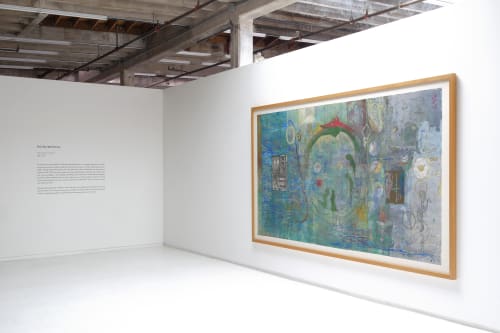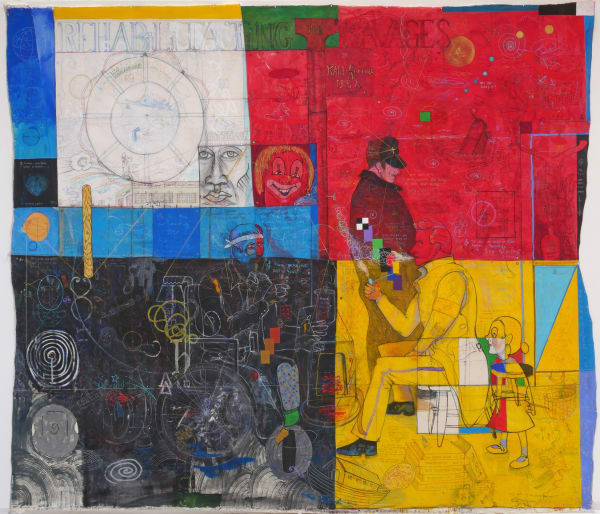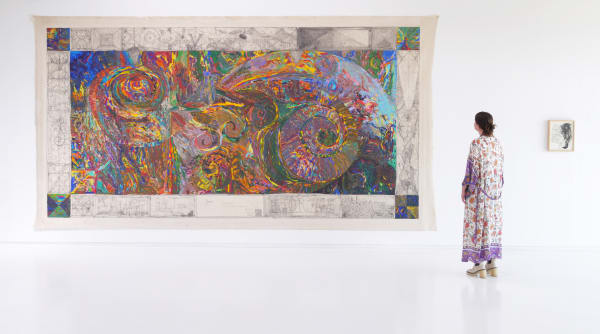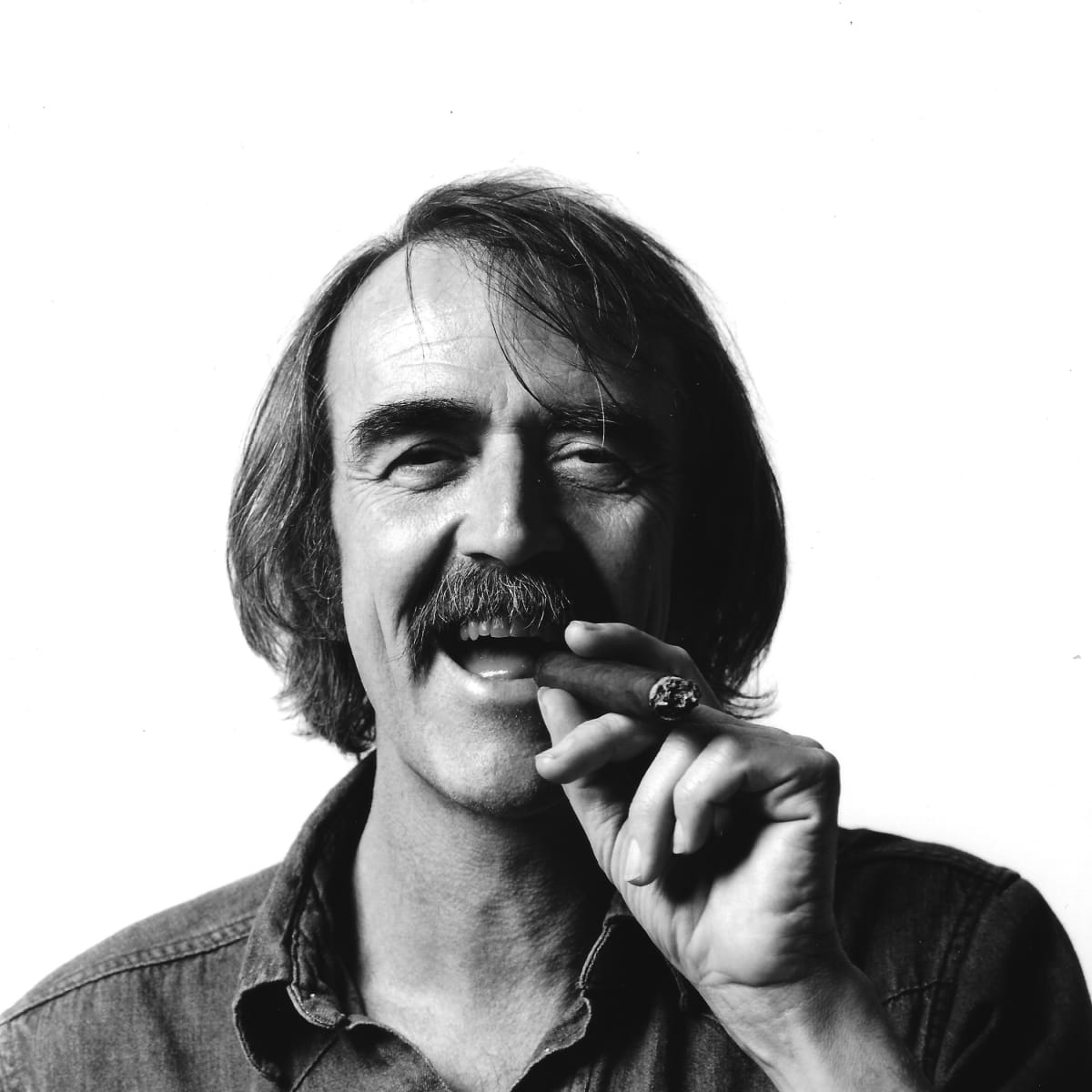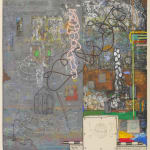William T. Wiley: MONUMENTAL
Enormous paintings comprise the heart of an exhibition honoring the colossus William T. Wiley, who died on April 25, 2021 at age 83. An audacious visionary, Wiley was an oracle, combining imagery, symbols, and wordplay to articulate social and environmental angst.
For nearly sixty years, Wiley (who was referred to by this single-word moniker by his family, friends, and professionally) distinguished himself as a renegade American artist whose interests were rooted in liberal social and environmental concerns as well as philosophy and spirituality. Though frequently political, his work adamantly resists classification into movements or stylistic trends. Wiley’s practice ranged from drawing, painting in watercolor and acrylic, sculpture, and assemblage to printmaking, filmmaking, and performance. Combining found objects, personal symbols, enigmatic texts, as well as references to art history, popular culture, and current events, he developed a distinctive visual vocabulary that allowed for variety, invention, and his own subtle mysticism.
But the defining hallmark of Wiley’s work is the text and wordplay that accompany nearly every piece he made. From stream-of-consciousness rambles to pointed critiques, he used humor, puns, sarcasm, and double entendre to address the most consequential issues of our time.
Joann Moser, curator of the Smithsonian American Art Museum, wrote in a 2009 retrospective catalogue, “Wiley has created a body of work that anticipated such important developments as installation art, audience participation, a revival of interest in drawing, as well as the use of humor and language as significant aspects of contemporary art.”
In 1960, Wiley’s work was included in The Whitney Museum’s “Young America” show, then again in “Fifty California Artists” in 1962, and in Whitney Annual exhibitions in 1967, 1968, and the 1983 Biennial. Other museum exhibitions include MoMA (New York); SFMOMA; Museum of Contemporary Art, Chicago; LACMA; Corcoran Gallery of Art (Washington DC); Museum of Fine Arts, Boston and many other museums in America and Europe. His work was included in Documenta V in Kassel, Germany in 1972 and the Venice Biennales in 1972 and 1980.
In 1963, at the age of 26, Wiley was hired to teach at the newly formed art department at the University of California, Davis. He and fellow artists Wayne Thiebaud, Robert Arneson, Roy De Forest and Manuel Neri transformed what was known only as an agricultural college into one of the leading art schools in America. Among Wiley’s students were Deborah Butterfield, Richard Shaw, and Bruce Nauman, with whom Wiley collaborated on various projects. Wiley retired from teaching in 1973 but continued to be a guest lecturer and visiting professor at many art schools and universities throughout the U.S.
In 1982, Wiley was the subject of his first retrospective, “Wiley Territory,” curated by the Walker Art Center in Minneapolis, which toured to the Dallas Art Museum, The Denver Art Museum, Des Moines Art Center, San Francisco Museum of Modern Art, and Phoenix Art Museum. In 2009, the Smithsonian American Art Museum organized the major retrospective, “What’s It All Mean: William T. Wiley in Retrospect,” which traveled to the Berkeley Art Museum and Pacific Film Archive. His work has been collected by nearly every museum in the United States as well as dozens of institutions internationally.
Concurrent and upcoming exhibitions of Wiley’s work in the Bay Area:
On view at the di Rosa Center for Contemporary Art in Napa through October 31 is “Fort Phooey: Wiley in the Studio,” an exhibition which recreates the sights and sounds of Wiley’s iconic studio. “William T. Wiley and the Slant Step: All on the Line” opens at the Manetti Shrem Museum of Art at UC Davis on January 11, 2022.
-

-

-
 William T. WileyIs This Fair?, 2000watercolor and ink on paper30 x 22 in
William T. WileyIs This Fair?, 2000watercolor and ink on paper30 x 22 in
76.2 x 55.88 cm -

-

-

-

-

-

-
 William T. WileyMeasuring Mirth, Girth and Worth, 1996mixed media on canvas51 x 178 1/2 in
William T. WileyMeasuring Mirth, Girth and Worth, 1996mixed media on canvas51 x 178 1/2 in
129.5 x 453.4 cm -

-
 William T. WileyGetting the Word Out, 1993acrylic and charcoal on canvas79 1/2 x 138 in
William T. WileyGetting the Word Out, 1993acrylic and charcoal on canvas79 1/2 x 138 in
201.9 x 350.5 cm -

-

-
 William T. WileyWho Is Not a Slave, 1987acrylic, charcoal and graphite on canvas
William T. WileyWho Is Not a Slave, 1987acrylic, charcoal and graphite on canvas
98 x 197 in
248.9 x 500.4 cmaccompanied by Who is Not a Slave (part b), 1987
ink and pencil on paper
14 x 11 in
35.56 x 27.94 cm -
 William T. WileyThe Hearings & Abstraction with No Punch, 2004acrylic, graphite and mixed media on paper with wire, lead weights, twine, tape and carved slate64 1/2 x 44 x 10 1/2 in
William T. WileyThe Hearings & Abstraction with No Punch, 2004acrylic, graphite and mixed media on paper with wire, lead weights, twine, tape and carved slate64 1/2 x 44 x 10 1/2 in
163.8 x 111.8 x 26.7 cm -
 William T. WileyRehabilitating the Savages, 2006mixed media on canvas128 x 145 in
William T. WileyRehabilitating the Savages, 2006mixed media on canvas128 x 145 in
325.1 x 368.3 cm -

